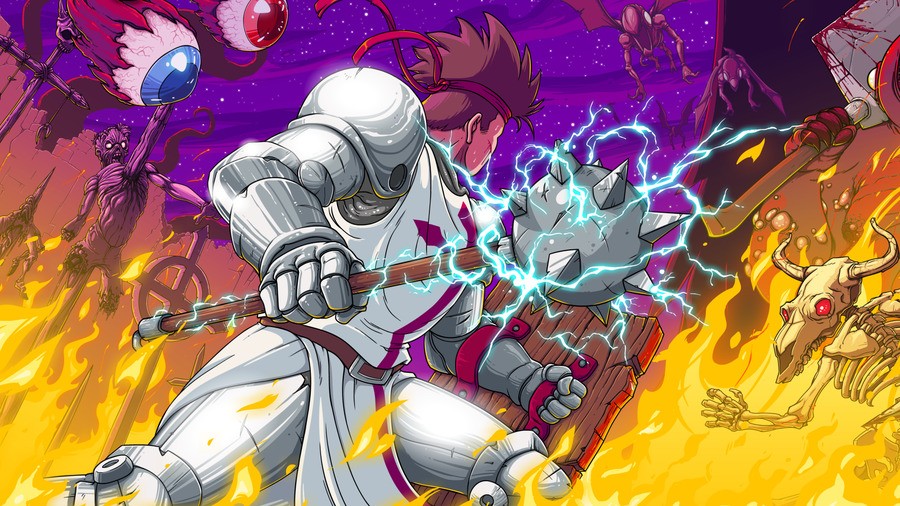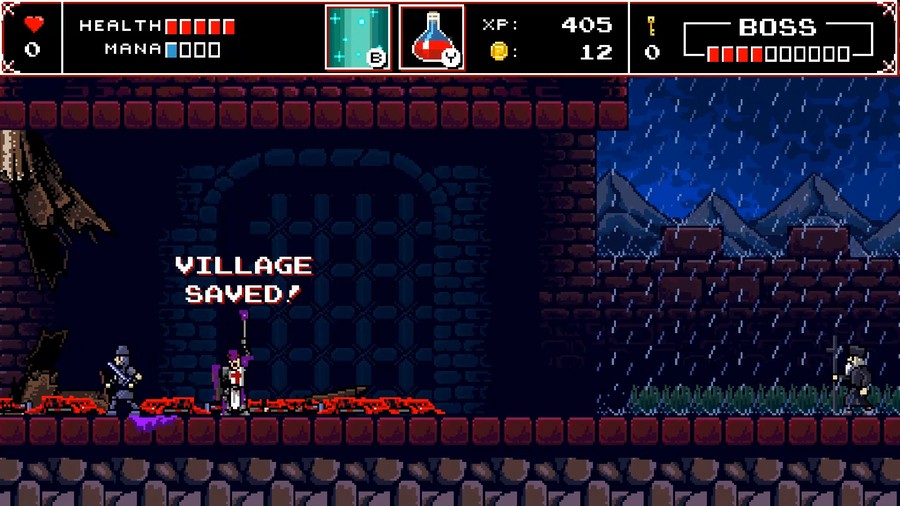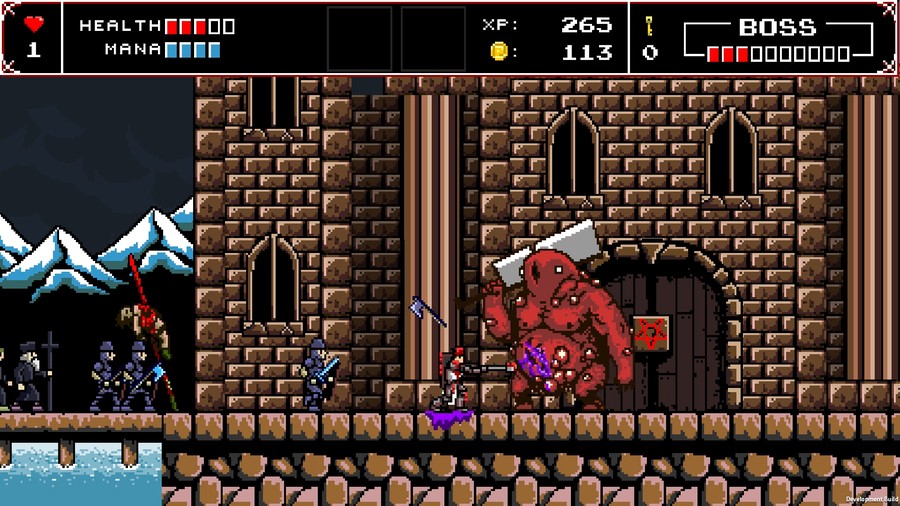
If you're into modern games with retro style, you've got no shortage of options on Switch. For years now talented younger developers have been channelling nostalgia and affection for the games of their youth into new titles that update classic mechanics and genres with mod-cons and 21st century flair. Games like Shovel Knight might feel like you could have been playing them in the '80s, but there are typically myriad little enhancements and features included that are only possible thanks to modern tech, however brilliantly authentic the game looks and feels.
The very latest game to scratch that delicious retro itch is Infernax from Berzerk Studio, a challenging 2D Metroidvania-style adventure which nods towards such classic NES titles as Zelda II, Ninja Gaiden and Castlevania — quite the touchstones! Having thoroughly enjoyed Berzerk's glorious Just Shapes & Beats, we were eager to see how the developer fared in this very different genre.
 Watch on YouTube
Watch on YouTubeSubscribe to Nintendo Life on YouTube841k
The game is out on Valentine's Day and to find out more we recently spoke via email to Berzerk Studio's Mike Ducarme and Hunter Bond. The answers below are compilation responses from both developers.
Nintendo Life: Can you discuss some of the design and creative decisions that brought the team towards Infernax in the early days of the project, as it's a very different style and genre to your last Switch game, Just Shapes & Beats?

In the very beginning, Infernax was actually a small-scale project similar to many of Berzerk’s early games, and was designed as an online Flash game. If you go through Berzerk’s back catalog of games, you’ll see a lot of games that are very arcade and retro game inspired during those times, so since Infernax was actually technically started 12 years ago, a lot of that OG Berzerk Studio DNA is still very present in the final version of the game today.
Just Shapes & Beats though was and still kind of is an outlier in our portfolio. A big factor of it is that Just Shapes & Beats was the brainchild of one of our other founders, Simon “Lachhh” Lachance while Infernax’s creative direction on the other hand is from Etienne, one of the other three original co-founders of Berzerk Studio.
Different brain, different game, same underlying Berzerk DNA.
What were the most influential games, as sources or inspiration or reference, when you started work on the project?
Infernax obviously wears a lot of its inspiration on its sleeve, and in this case we’re talking a lot about Zelda II and Castlevania II. Often when describing the game we’ve called it a Zeldavania, because many of the elements in the game that would cause some to call it a Metroidvania are actually mostly inspired by the second Zelda game for NES.
Other less obvious sources of inspiration were looking at historical sources like accounts directly from documented knights like Jean De Joinville, and historical accounts like the Battle of Agincourt. Obviously Infernax leans very heavily into the supernatural horror of its setting, but when working on things like dialog and characterization we definitely had a lot of conversations around how the fact that the player is controlling the Duke of this land would change the way NPCs interact with them.
Heavy Metal had a large part in the soul of the game, obviously the imagery speaks for itself, but at times the tone of the game and the state of the lands can be quite bleak, and we drew inspiration from things like King Diamond, Mercyful Fate, and other bands whose work fit the feeling we wanted for the game.

The download / Indie scene in particular has a lot of retro-styled pixel art games, did you consider this a challenge or an opportunity in terms of getting Infernax to stand out?
It’s always interesting to answer this one, because technically since Infernax was conceived as an idea and the initial version coded almost 12 years ago, the original design predates many of the games people would think of when talking about the modern retro-art pixel scene. So to that effect, we weren’t concerned about it at all when we started, back then we just wanted to make a kick ass pixel game in Flash, really. But as we’ve wrapped it up I think we’ve come to the place where we’re happy about what we’re making, and know that for the audience who likes it, it’s going to be like we wrote their name on it. Watching other studios from Quebec that we’re close with release such killer games like The Messenger [from Sabotage] in the same space to wide acclaim can definitely be intimidating in a way, but we’re happy to have made what we made, and hope for the people who want what Infernax is, it’ll be received well too.
Infernax was actually technically started 12 years ago, a lot of that OG Berzerk Studio DNA is still very present in the final version of the game today
On this final round of development leading to release, we weren’t so worried about designing the game specifically to stand out, instead focusing on what the game already was and did well, and then bringing as much polish as possible so that all of those aspects felt really good to interact with. The great opportunity with Infernax is that because of the historically mixed feelings towards Zelda II and Castlevania II, it’s pretty fresh soil as opposed to the well-worn path of following one of the more traditionally beloved mainline games from either series.
For those coming into the game fresh, can you outline the gameplay loop between town / village sections and action segments?
Villages are where most of the NPC’s live, and often are both quest hubs and important story locations. This is where you prepare your next adventure, get to know the villagers and their troubles and see if there’s anything for you to do. It’s not just a pit stop between two places where you buy new gear and promptly leave, it’s a part of your journey, of your story.
Your choices during the game can and will have an effect on the state of the villages and the people who inhabit them as the game goes on; they are not just idly walking around while the world burns around them, they are a part of the world just as much as the player.

Choice and consequences are a key part of the game, can you give an example of how a key choice can affect a playthrough?
Each choice piles upon others as the game goes on not only to change the eventual ending the player receives, but to change the playstate itself.
Depending on choices made, a player may have less resources available, or the spells and equipment offered will vary in the play-through based on the choices they’ve made during that playthrough. Some may make the game more difficult, but generally most serve to give differing experiences.
It’s kind of hard to say more without spoiling story moments, in a nutshell, things happen when you do things, or when you don’t do things; you can’t stop the circle of things happening, you can only try to make the things happening happen the way you want them to happen.
In the demo we played pre-release we didn't get to try out the mana / magic elements; can you talk a little about this feature? Are there multiple spells and opportunities to level up this ability?
As with the games that inspired it, especially Zelda II, the magic in the game is both functional in combat, but also at times serves to aid the player in certain tasks in the game. Depending on the path the player chooses, the exact effects and spells available may vary, making for a wider range of playthroughs than if there was a single static set of spells.
The game has a fair amount of gore and 'disgusting' boss designs. How important is that to the tone of the game, and what inspired that approach to the art design?
The Creative Director on the project, Etienne, likes to point to horror films from the '80s and '90s like Evil Dead and Brain Dead specifically for the gross-out aesthetic choices, in addition to in the case of Evil Dead how much it was used to play into the comedy.
Obviously the over-the-top gore and boss designs weigh heavily visually on the tone of the game, but they also play an important role in unifying the horror undertones of the entire game with the lo-fi pixel art. The initial idea behind the whole thing 12 years ago was to make a game that looked like it was straight out of the '80s, but could never have been greenlit, that all played a big part in trying to convey that feeling of “the game that was too bad for the public”.
As an elevator pitch, what can players expect when they play Infernax?
I mean, factually they can expect to play a video game, the video game contains a combination of pixels of a large range of different colors and emits sounds provided an audio output is present.
Joking aside, we tried our best to take what we loved most about the games that inspired us and to make it our own, then dumped a bucketload of pixelated gore over it, for good measure you know!
Hopefully Infernax will make them feel like they are right back in their couch fort sipping on Capri Suns on a Saturday morning, trying to figure out every little secret the game has to offer.
Many thanks to Mike and Hunter. Infernax is out on Switch and other platforms on Monday 14th February, and it's very good.





Comments 19
I'll admit I wasn't really paying this much attention, but I might have to check it out. These guys sound fun, and I spent many, many hours playing these games back in the day.
I was ready to buy after then first trailer! Anyone see what happens when you use the Konami code?!?!
Zeldavania? That’s a new one.
Removed - unconstructive; user is banned
I like the sound of that! Now let's get a proper remake of Zelda II.
I don't think Evil Dead was trying to play into the comedy aspect of horror until 3 came along. The first two were UNINTENTIONALLY hilarious.
To me it looks like a Contra / Castlevania mashup...
I see no Zelda 2
@Dezzy70 No because Nintendo has a bigger investment on first parties evergreen exclusives compared to Sony and are a big reason why their HW sells. Sony meanwhile has much bigger gaps for their first party releases [barely any Sony released PS5 exclusives for one] and rely more on third parties to carry compared to Nintendo that it’s less of a big deal if Sony ports their older titles to PC specifically because a sequel release is Sony exclusive. Sony relies on PC more then what Nintendo would realistically.
Btw BoTW has 25.8 [not 20] million sales as of Dec 2021 just from the Switch [Wii U version isn’t even counted which is less then 2 million] where evergreens rarely goes on sale [and usually like $15-20 off at best] where it is still sold $60 standard while HZ just touched 20 M on Nov 2021 with PS4/PC with the game getting heavy sales multiple times on both platforms where the game was priced as low as $20 often.
BoTW isn’t even their biggest Nintendo exclusive. MK8D is almost double that and still sells good everywhere weekly at full price years later. Porting their games to Steam that takes a 30% cut of their sales would benefit Valve more then Nintendo. Tons of people would be buying on Steam shop instead of Eshop which is 30% less money in their pocket. Not to mention porting their games on Steam comes with the expectation of “wait for sale” from Steam people way more often compared to the Nintendo E-shop [or physical orders] where Nintendo people are way more open at buying a game full price day 1.PC people would bitch if they see BoTW launch with a $60 price tag on the store which is the norm for Nintendo shop. Moment a single Nintendo game gets ported you are gonna get a bunch of “I’ll wait for the PC port” just like PlayStation is now dealing with.
You are better off emulating if you really want to play a Nintendo game on PC. Nintendo hasn’t even ported actual games to mobile market which is BIGGER then PC. Nintendo only released spin-offs live service and Gacha game so if PC gets anything from Nintendo it would be that.
If Nintendo thought PC was remotely worth it where it had more pros then cons on THEIR business model then they would have done it a long time ago and just followed the way of the Xbox. Considering how much the Switch is doing just fine HW and SW wise they don’t need to rely on a PC secondary market when they can consolidate all the sales on their own platform.
TLDR: Nintendo is the last game entity in the industry that would listen to PC port begging.
@Arawn93
Just thought it might be an idea for them.
I play them on Switch docked on 65” 4K tv, that’s the best way to play in my opinion, get drawn etc and good for 4 player Mario Kart 8D.
I can't wait to play this. Wishlisted.
@Greatluigi
Zeldavania: cynical me says probably a marketing ploy to try and differentiate it from other games. I like the look of it though.
Man, the wait for LRG LE is going to be tough.
Really looking forward to playing this.
Ahh, yes... a Zel2gaidroidvania.
@Dezzy70 This is a terrible idea. People buy Nintendo systems to play Nintendo games. Nintendo would only do this if the company was at the brink of bankruptcy.
I didn't expect all the gore, but I love it. Reminds me of that infamous flesh melting scene from the NES's Sweet Home.
Holy smokes, this looks amazing. I’m gonna get this one.
My friend just sent this to me tonight to check out. Wow just wow!! So awesome looking. And the Konami code!! Lol that's just icing on the cake! We both agree Happy Valentine's Day to us!... Well everyone!
But Zelda II isn't a Metroidvania in the slightest. I wish people would get their labels straight and not to retroactively shoehorn older games into genres that make no sense. This just looks like a sidescrolling adventure game.
I am playing through this one now, close to the end. It is tough as nails and freakin' awesome.
Show Comments
Leave A Comment
Hold on there, you need to login to post a comment...